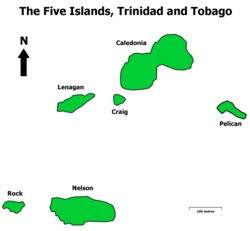
Nelson Island, Trinidad and Tobago
Encyclopedia

Trinidad and Tobago
Trinidad and Tobago officially the Republic of Trinidad and Tobago is an archipelagic state in the southern Caribbean, lying just off the coast of northeastern Venezuela and south of Grenada in the Lesser Antilles...
is one of the Five Islands which lie west of Port of Spain
Port of Spain
Port of Spain, also written as Port-of-Spain, is the capital of the Republic of Trinidad and Tobago and the country's third-largest municipality, after San Fernando and Chaguanas. The city has a municipal population of 49,031 , a metropolitan population of 128,026 and a transient daily population...
in the Gulf of Paria
Gulf of Paria
The Gulf of Paria is a shallow inland sea between the island of Trinidad and the east coast of Venezuela. This sheltered body of water is considered to be one of the best natural harbours on the Atlantic coast of the Americas...
.
Nelson Island is famous as the disembarkation point and quarantine
Quarantine
Quarantine is compulsory isolation, typically to contain the spread of something considered dangerous, often but not always disease. The word comes from the Italian quarantena, meaning forty-day period....
station for indentured
Indentured servant
Indentured servitude refers to the historical practice of contracting to work for a fixed period of time, typically three to seven years, in exchange for transportation, food, clothing, lodging and other necessities during the term of indenture. Usually the father made the arrangements and signed...
immigrants to Trinidad and Tobago in the nineteenth and early twentieth century. For this reason it has been called the Ellis Island
Ellis Island
Ellis Island in New York Harbor was the gateway for millions of immigrants to the United States. It was the nation's busiest immigrant inspection station from 1892 until 1954. The island was greatly expanded with landfill between 1892 and 1934. Before that, the much smaller original island was the...
of Trinidad and Tobago.
At Nelson Island the Indian immigrants and the ship, food and stores were inspected by the Protector of Immigrants. Their bundles and blankets were fumigated and they were quarantined and allowed to recover and regain strength. This measure was designed to prevent the spread of diseases which might have been transported from India. Special effort was made to stop the spread of smallpox
Smallpox
Smallpox was an infectious disease unique to humans, caused by either of two virus variants, Variola major and Variola minor. The disease is also known by the Latin names Variola or Variola vera, which is a derivative of the Latin varius, meaning "spotted", or varus, meaning "pimple"...
and measles
Measles
Measles, also known as rubeola or morbilli, is an infection of the respiratory system caused by a virus, specifically a paramyxovirus of the genus Morbillivirus. Morbilliviruses, like other paramyxoviruses, are enveloped, single-stranded, negative-sense RNA viruses...
. At Nelson Island, the immigrants were examined by a medical doctor and then transported by small boats to Port of Spain. The healthy ones were immediately sent to estates, the sick ones went to the Colonial Hospital in Port of Spain and those who only needed rest were kept at the Depot in Port of Spain.
In the 1930s Nelson Island was used as a detention center for prisoners, among them Tubal Uriah Butler
Tubal Uriah Butler
Tubal Uriah "Buzz" Butler , was a Grenadian-born Spiritual Baptist preacher and labour leader in Trinidad and Tobago...
. During World War II
World War II
World War II, or the Second World War , was a global conflict lasting from 1939 to 1945, involving most of the world's nations—including all of the great powers—eventually forming two opposing military alliances: the Allies and the Axis...
, the Americans
United States
The United States of America is a federal constitutional republic comprising fifty states and a federal district...
built a gun emplacement at the eastern end of the island and a causeway to Rock Island to the west. Nelson Island became a detention center again in 1970 following the Black Power Revolution
Black Power Revolution
The Black Power Revolution, also known as the "Black Power Movement", 1970 Revolution, Black Power Uprising and February Revolution, was an attempt by a number of social elements, people and interest groups in Trinidad and Tobago to force socio-political change.-History:Between 1968 and 1970 the...
. Among those who were detained there were Oilfields Workers' Trade Union
Oilfields Workers' Trade Union
The Oilfields Workers Trade Union or OWTU is one of the most powerful trade unions in Trinidad and Tobago. Currently led by Ancil Roget, the union was born out of the 1937 labour riots, the union was nominally led by the imprisoned TUB Butler but was actually organised by lawyer Adrian Cola Rienzi...
president George Weekes, National Joint Action Committee
National Joint Action Committee
The National Joint Action Committee is a black nationalist political party in Trinidad and Tobago.-History:The party was established in February 1969 by Makandal Daaga , who was dissatisfied with the fact that most businesses in Trinidad at the time were owned by the white minority...
leader Geddes Granger
Geddes Granger
His Excellency Makandal Daaga, born Geddes Granger, is a Trinidad and Tobago political activist and former revolutionary. He is also a son of Gaskynd Granger, and cousin of David A. Granger. He was the leader of the 1970 Black Power Revolution. During the unrest he was arrested and charged. The...
, Apoesho Mutope, Winston Suite and Clive Nunez.
See also
- Islands of Trinidad and TobagoIslands of Trinidad and TobagoThis is a list of islands of Trinidad and Tobago. Trinidad and Tobago is an archipelagic republic in the southern Caribbean.-Bocas Islands:The Bocas Islands lie between Trinidad and Venezuela, in the Bocas del Dragón...

